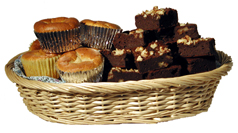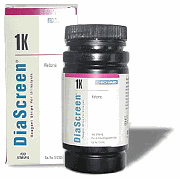|
|
Untitled Document
|
|
|
|
|
|
|
|
|
|
|
|
|
May 2002 |
|
WELCOME!
|
|
|
|
|
|
 |
|
|
|
|
|
|
|
|
|
|
Count
the Many Ways to Enjoy Decadent Desserts
|
|
|
If
you think that scrumptious desserts are off limits,
you haven't tried Fran Gare’s Decadent Desserts! |
|
|
|
|
Available in rich
chocolate and buttery almond flavor, these are the most incredible low carb desserts
that we have ever tasted . . . the possibilities are only limited by your imagination.
You can prepare brownies, fudge, puddings, cookies, cheesecake, ice cream, crème
brulee and much more.
So far, we have made brownies, fudge, macaroons, and almond muffins. Dahling,
they are "to die for!" The best part of the equation — aside from
the great taste of the desserts — is the ease of preparation. "Baking
isn’t my forte, I admit it," says Ruth, "but these recipes are
impossible to mess up. You can make a whole lot of brownies or muffins or just
a small batch so that your desserts are always fresh and appealing. And, they
can be made so quickly that you can pop a batch of brownies in the oven when unexpected
company arrives." Even those who are not on special diets will prefer Decadent
Desserts to their own sugary confections and desserts.
Kosher, sugar-free and wheat-free, the mixes appeal to a broad range of health-conscious
dieters: locarb'ers, diabetics, and those suffering from wheat allergies, candida,
or hypoglycemia (low blood sugar), to name a few.
When we first added Decadent Desserts to the menu at the LoCarbDiner, we needed
some photos to show you how delicious they are. Ruth dashed to the kitchen and
whipped up a batch of almond muffins and chocolate brownies, and we had great
fun setting up and taking photos with our digital camera. Then the real reward
came . . . we got to eat the display! It doesn't get any better than that!
One can (12 ounces) makes three substantial trays of desserts. In addition to
the recipes on the cans, you'll find more
recipes on Fran's web site, www.FranGare.com.
We hope that you will try these fabulous products for yourselves.
|
|
|
|
|
|
|
|
 |
Ketosis—
Burning Fat for Energy |
|
|
 |
Watch
Out . . .
For Hidden Carbs!
Food
Labels Don’t Always
Reflect Carbohydrate Counts
|
|
|
|
Do
you understand the role of ketosis in low-carb dieting? Here's a quick primer:
Your body burns two fuels for energy. Glucose, the primary fuel, comes from eating
carbohydrates. When your body runs out of glucose, it turns to its secondary fuel
source — your own body fat. When you reduce your intake of carbohydrates, your
body must convert fat into energy, and this metabolic state is called "ketosis."
So, being in ketosis simply means living off your fat stores. Assuming you are overweight,
this process is not only safe — it's desirable!
Ketosis is absolutely safe (unless you happen to have no excess body fat!) So, why
do so many people think ketosis is dangerous? According to the Atkins Center, the
misconception may be caused by confusing the term ketosis with another K-word, ketoacidosis.
Ketoacidosis is a potentially dangerous condition that occurs in a diabetic whose
blood sugar levels are out of control. Ketoacidosis is not a result of low carbohydrate
dieting.
To stimulate ketosis, the best diet is high in fat (cream cheese, macadamias, deviled
eggs, etc.), moderate amounts of protein and a very low level of carbohydrates.
You may also need to increase exercise from three times per week to four or five
times per week.
Many locarb'ers test their urine to determine if they have reached ketosis. For
most people, the Lipolysis
Testing Strips give an indication of how well they are adhering to the diet
by detecting the presence of ketones in your urine. The ketones are present when
your body is breaking down fat. When ketones are detected, the test strips turn
a shade of pink or purple. Some people have more trouble than others reaching ketosis
— either because they are metabolically resistant to weight loss or else they
are not fully aware of all sources of carbohydrates they may be eating.
Each person's metabolism level is different and therefore will turn the sticks a
varying degree of purple. In addition, the time of the day, whether or not you exercise,
and what you had at your last meal will all affect the ketone test strips. It does
not necessarily matter whether you are turning the strips a dark or light color.
The important thing is that you are in ketosis. and you are burning fat for energy.
However, keep in mind that every individual's metabolism is different, and as a
result, there are people who never even get into ketosis, yet lose all the weight
they want. The Atkins Center also recommends that you not over test yourself. They
recommend that you test your ketosis level no more than once a week.
If you are having trouble reaching ketosis, don't make the common mistake of eating
less fat to get into ketosis; the opposite is actually true. To really understand
what is occurring in your body, we strongly suggest you read Dr. Atkins New Diet
Revolution.
The above information is from the official Atkins Center website. Please feel free
to visit www.atkinscenter.com
for more
information. |
|
|
|
|
Did you know that
"zero carbs" doesn't always mean "zero carbs?" Most reduced
carbohydrate dieters have come to think of any food with zero grams of carbohydrate
reported on the Nutrition Facts label as one they can eat in unlimited quantities.
The truth is that nearly all foods contain some carbohydrate, and these small
hidden amounts can really add up!
"Hidden carbohydrate is carbohydrate that is not immediately obvious in products
or by reading the Nutritional Facts Label," states Laura Richard, B.S.N.,
M.H.A., in her book, The Secret To Low Carb Success! How
To Get The Most Out of Your Low Carbohydrate Diet. "That is because
the guidelines governing food labels allow manufacturers to list the carbohydrate
content of a food as 0 grams if the actual count is less than 1 gram of carbohydrate
per cup."
Look at the Nutrition Facts label and try this formula: Count 9 calories per gram
of fat (e.g., "Fat 5g" x 9 = 45 calories), count 4 calories per gram
of protein, and 4 calories per gram of carbohydrate. Add up the calories and compare
your total to the total calories reported on the label. If your total falls short,
you can assume that the missing calories are the result of gram counts rounded
down from 1 to 0. For example, 4 missing calories may actually be 1 unreported
gram of carbohydrate!
Case in point. Splenda has recently changed their packaging from the familiar
pale yellow to a new blue and white package. On the old package they reported
0 carbs and 0 calories, but on their new package they report 4 calories and 1
gram of carbohydrate per single-serving packet! A hidden carb has been revealed!
Here are some common sources of "hidden carbs":
• coffee: approx. 1 gram per cup
• maltodextrin, in instant tea: 1.25 grams per
cup
• cheese: up to 1 gram per ounce
• eggs: up to 1 gram per egg, depending on size
• sugar-free mints and gums: 2 grams per stick
• artificial sweeteners: 1 gram per packet or
1 tsp.
• imitation seafood: 2-3 grams per ounce
• curry and garlic powder: 4-6 grams per Tbsp.
• onion: 3 grams per 1/4 cup, chopped
Read the Nutritional Label and the Ingredients List of the foods that you eat.
If there are sugars or other sources of carbohydrate in the ingredient list, there
is carbohydrate in the food. You could be unknowingly adding 5-10 grams of carbohydrate
to your daily diet, which could, in some cases, slow weight loss.
Remember — for Atkins induction dieting, the goal is to stay under 20 grams
of carbohydrates per day. For ongoing weight loss, your goal depends on your own
metabolic resistance level, but it is probably around 40 grams per day.
Laura Richard’s informative book is available through our web site. Visit
our home page www.LoCarbDiner.com for
information on how to order Ms. Richard’s breakthrough book on Low Carbohydrate
Diets.
|
|
 |
 |
 |
 |
 |
 |
 |
 |
 |
 |
 |
 |
|
|
|



